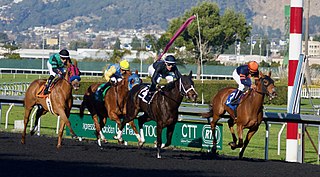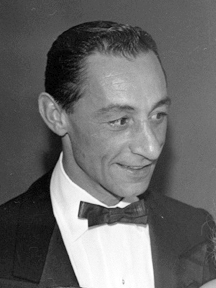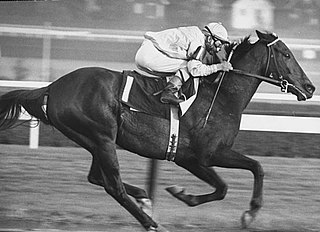
The Triple Crown of Thoroughbred Racing, often shortened to Triple Crown, is a series of horse races for Thoroughbreds, often restricted to three-year-olds. Winning all three of these Thoroughbred horse races is considered the greatest accomplishment in Thoroughbred racing. The term originated in mid-19th-century England and nations where Thoroughbred racing is popular each have their own Triple Crown series.

Secretariat, also known as Big Red, was a champion American thoroughbred racehorse who was the ninth winner of the American Triple Crown, setting and still holding the fastest time record in all three of its constituent races. He is considered by many to be the greatest racehorse of all time. He became the first Triple Crown winner in 25 years and his record-breaking victory in the Belmont Stakes, which he won by 31 lengths, is widely regarded as one of the greatest races in history. During his racing career, he won five Eclipse Awards, including Horse of the Year honors at ages two and three. He was nominated to the National Museum of Racing and Hall of Fame in 1974. In the Blood-Horse magazine List of the Top 100 U.S. Racehorses of the 20th Century, Secretariat was second to Man o' War.

Nijinsky was a Canadian-bred, Irish-trained champion Thoroughbred racehorse and sire. He was the outstanding two-year-old in Europe in 1969 when he was unbeaten in five races. In the following season, he became the first horse for thirty-five years to win the English Triple Crown, a feat that has not been repeated as of 2023. He is regarded as one of the greatest European flat racehorses of the 20th century.

Horse racing is an equestrian performance sport, typically involving two or more horses ridden by jockeys over a set distance for competition. It is one of the most ancient of all sports, as its basic premise – to identify which of two or more horses is the fastest over a set course or distance – has been mostly unchanged since at least classical antiquity.

Harness racing is a form of horse racing in which the horses race at a specific gait. They usually pull a two-wheeled cart called a sulky, or spider, or chariot occupied by a driver. In Europe, and less frequently in Australia and New Zealand, races with jockeys riding directly on saddled trotters are also conducted.

The Standardbred is an American horse breed best known for its ability in harness racing, where members of the breed compete at either a trot or pace. Developed in North America, the Standardbred is recognized worldwide, and the breed can trace its bloodlines to 18th-century England. They are solid, well-built horses with good dispositions. In addition to harness racing, the Standardbred is used for a variety of equestrian activities, including horse shows and pleasure riding, particularly in the Midwestern and Eastern United States and in Southern Ontario.
Albatross (1968–1998) was a bay Standardbred horse by Meadow Skipper. He was voted United States Harness Horse of the Year in 1971 and 1972. Albatross won 59 of 71 starts, including the Cane Pace and Messenger Stakes in 1971, earned $1,201,477. It was, however, as a sire that he really made his mark. Albatross's 2,546 sons and daughters won $130,700,280.

War Admiral was a champion American Thoroughbred racehorse who is the fourth winner of the American Triple Crown. He was also the 1937 Horse of the Year and well known as the rival of Seabiscuit in the 'Match Race of the Century' in 1938. War Admiral won 21 of his 26 starts with earnings of $273,240 and was the leading sire in North America for 1945. He was also an outstanding broodmare sire whose influence is still felt today in descendants such as Triple Crown winners American Pharoah and Justify.

George Edward Arcaro, was an American Thoroughbred horse racing Hall of Fame jockey who won more American classic races than any other jockey in history and is the only rider to have won the U.S. Triple Crown twice. He is widely regarded as one of the greatest jockeys in the history of American Thoroughbred horse racing. Arcaro was born in Cincinnati, Ohio, the son of an impoverished taxi driver. His parents, Pasquale and Josephine, were Italian immigrants and his father held a number of jobs, including taxi driver and operator of an illegal liquor enterprise during Prohibition. Arcaro was born prematurely, and weighed just three pounds at birth; because of this, he was smaller than his classmates and was rejected when he tried out for a spot on a baseball team. His full height would reach just five-foot, two inches. Eventually nicknamed "Banana Nose" by his confreres, Arcaro won his first race in 1932 at the Agua Caliente racetrack in Tijuana, Mexico; he was 16 years old. In 1934, the inaugural year of Narragansett Park, Arcaro was a comparative unknown who rode many of his early career races at 'Gansett.

Whirlaway was a champion American Thoroughbred racehorse who is the fifth winner of the American Triple Crown. He also won the Travers Stakes after his Triple Crown sweep to become the first and only horse to win all four races.

Sunday Silence was an American-bred Thoroughbred racehorse and sire. In 1989, he won the Kentucky Derby and the Preakness Stakes but failed to complete the Triple Crown when he was defeated in the Belmont Stakes. Nevertheless, he won the Breeders' Cup Classic and was voted American Champion Three-Year-Old Colt and American Horse of the Year that same year. Sunday Silence's racing career was marked by his rivalry with Easy Goer, whom he had a three to one edge over in their head-to-head races. Easy Goer, the 1988 American Champion Two-Year-Old Colt finished second to Sunday Silence in the Kentucky Derby the Preakness, and the Breeders' Cup Classic. However, Easy Goer prevailed by eight lengths in the Belmont denying Sunday Silence the Triple Crown. Both horses were later voted into the American Hall of Fame.

The British Classics are five long-standing Group 1 horse races run during the traditional flat racing season. They are restricted to three-year-old horses and traditionally represent the pinnacle of achievement for racehorses against their own age group. As such, victory in any classic marks a horse as amongst the very best of a generation. Victory in two or even three of the series marks a horse as truly exceptional.
The Arkansas Derby is an American flat Thoroughbred horse race for three-year-olds held annually in April at Oaklawn Park in Hot Springs, Arkansas. It is currently a Grade I race run over a distance of 1 1/8 miles on dirt.

Harness racing, also colloquially known as trotting or the trots, is a spectator sport in Australia, with significant amounts of money wagered annually with bookmakers and the Totalisator Agency Board (TAB). In Australia there are 90 harness racing tracks, which hold over 1,900 meetings annually. There are approximately 2,900 drivers and 4,000 trainers with about 5,000 Standardbred horses foaled and registered each year.

Majestic Prince was a Thoroughbred racehorse. One of the leading North American horses of his generation, he won the Kentucky Derby and Preakness Stakes in 1969.
Burgoo King (1929–1946) was an American Thoroughbred racehorse who won the first two legs of the U.S. Triple Crown series but who did not run in the final race, the Belmont Stakes.

In the United States, the Triple Crown of Thoroughbred Racing, commonly known as the Triple Crown, is a series of horse races for three-year-old Thoroughbreds, consisting of the Kentucky Derby, Preakness Stakes, and Belmont Stakes. The three races were inaugurated in different years, the last being the Kentucky Derby in 1875. The Triple Crown Trophy, commissioned in 1950 but awarded to all previous winners as well as those after 1950, is awarded to a horse who wins all three races and is thereafter designated as a Triple Crown winner. The races are traditionally run in May and early June of each year, although global events have resulted in schedule adjustments, such as in 1945 and 2020.
Horse racing in the United States dates back to 1665, which saw the establishment of the Newmarket course in Salisbury, New York, a section of what is now known as the Hempstead Plains of Long Island, New York. This first racing meet in North America was supervised by New York's colonial governor, Richard Nicolls. The area is now occupied by the present Nassau County, New York, region of Greater Westbury and East Garden City.

The Grand Slam of Thoroughbred racing is an informal name for winning four major Thoroughbred horse races in one season in the United States. The term has been applied to two configurations of races, both of which include the races of the Triple Crown—the Kentucky Derby, Preakness Stakes and Belmont Stakes—and either the Travers Stakes or the Breeders' Cup Classic as the final race.















